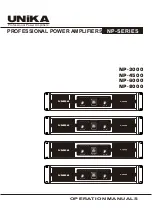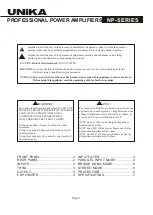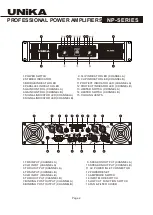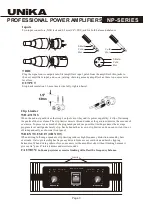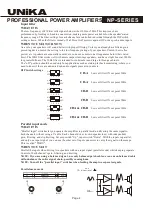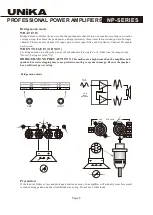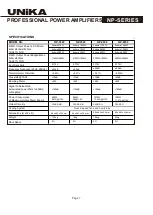
Input filter
WHAT IT IS
The low-frequency (LF) Filter rolls signals below either 30Hz or 50Hz. This improves bass
performance by limiting sub-audio cone motion, making more power available for the speaker's rated
frequency range. The filter settings for each channel are controlled individual through the DIP switch
settings shown. When the filter is turned off, a 5Hz roll off protects against DC or deep sub-audio inputs
WHEN TO USE IT (OR NOT)
As a rule, your speakers will sound better with proper filtering. Unless you already have filtering in a
preceding device, match the setting to the low frequency rating of your speakers. Vented (bass reflex,
ported, etc.) speakers are especially sensitive to cone over-excursion at frequencies below their rated
limit. The 50Hz filter works well with most compact full-rage speakers, and has a slight boost at 100Hz
for greater fullness. The 30Hz filter is intended for subwoofers and large full-range cabinets.
The "off" position should be used only for applications such as studio playback monitoring, where you
need to know if there are unwanted sub-audio signals present in your mix.
DIP Switch settings
Page 4
ON
OFF
ON
OFF
1 2 3 4
ON
OFF
ON
OFF
1 2 3 4
ON
OFF
ON
OFF
1 2 3 4
ON
OFF
ON
OFF
1 2 3 4
ON
OFF
ON
OFF
1 2 3 4
ON
OFF
ON
OFF
1 2 3 4
Low cut filter ON cut point 30Hz
Low cut filter ON cut point 50Hz
Low cut filter ON cut point 30Hz
Low cut filter ON cut point 50Hz
Low cut filter ON cut point 30Hz
Low cut filter ON cut point 50Hz
CH-A
CH-B
CHA & CH-B
CHA & CH-B
CH-A
CH-B
Parallel input mode
WHAT IT IS
"Parallel input" switches let you operate the amplifier in parallel mode, delivering the same signalto
both channels without using a Y-cable. Each channel drives its own speaker load, with independent
gain, filtering, and clip limiting. Set amp switch "Up", input switch "Down". With the inputs in parallel,
and only one input signal, you can use the other set of input connectors to carry the signal to other amps.
This is called "THRU" .
WHEN TO USE IT
Parallel the inputs when driving two speakers with one input signal (parallel mode) while keeping separate
Control of both channel's gain, filtering, and limiting.
NOTE: If you are using a balanced signal , use only balanced patch cables; even one unbalanced cable
will unbalance the entire signal chain, possibly causing hum.
NOTE: Turn off the "parallel input" switches when feeding the amp two separate signals.
STEREO
PARALLEL
BRIDGE
UP
UP
DOWN
INPUT
UP
DOWN
UP
AMP
Parallel mono mode
CH-A
SIGNAL INPUT
CH-A
CH-B
CH-B
NO INPUT!
PROFESSIONAL POWER AMPLIFIERS
UNiK A
NP-SERIES

